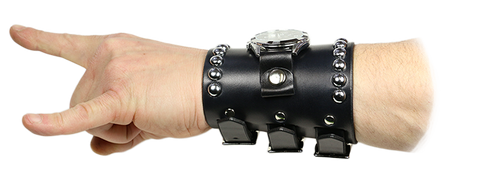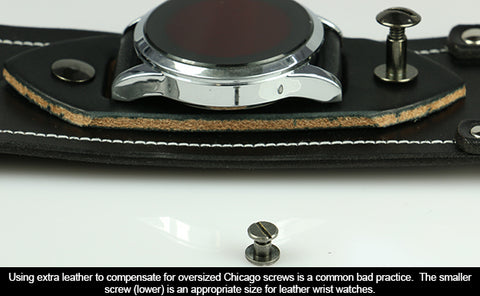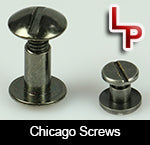Skip to content
Skip to side menu
Home
→
What To Know Before You Buy A Leather Watch Cuff
What To Know Before You Buy A Leather Watch Cuff
This article is for people who want to own a wide leather watch cuff, but have limited knowledge about leather and timepieces. This guide will help you understand what you should know before you invest in a leather cuff and watch. In terms of quality, I’m not talking about a $20,000 Rolex, but instead the timepieces that are priced in the $200 or less range, which tend to dominate the market. I originally had analog watches in mind, but the information here still largely applies to smart watches, also.
One of the aspects of the watch industry I find odd is just how little attention is given to the watch band, especially when it’s made from leather, or at least their version of leather. A decent watch can easily outlive the factory made band that it came with. The 'leather' band is a secondary concern for most watch makers.
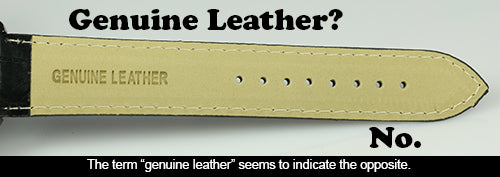
So if your current watch strap is worn out and you're thinking of keeping the timepiece and just replacing the strap, there are many choices. In fact, many aftermarket watch cuffs and bands are really nice, from a leather perspective. But, some of them only look nice in photography and lack significant quality. How do you tell the difference?
Here's a few simple things to look for when you’re searching for a new watch cuff:
If you plan to use your own time piece, make sure it can actually be fitted into the cuff. If you don't see examples of their watch cuffs in use and/or the description is vague, you may run into issues where the leather is too thick(heavy) to slip between the pin and the case.
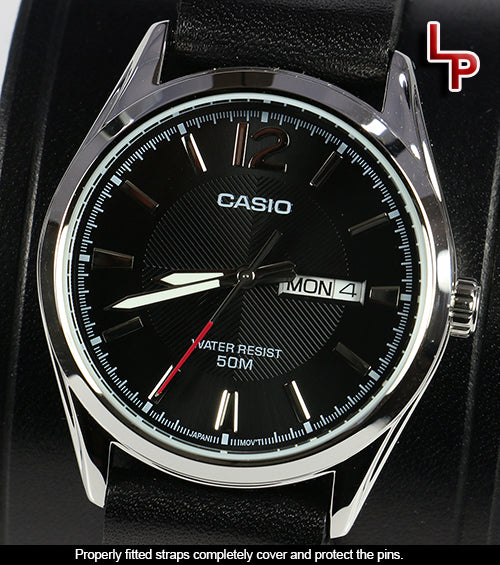
In regards to how the timepiece rests on the cuff, avoid generic one size fits all configurations. The straps which slip between pins should equal the span of the pin, otherwise too much exposed pin risks damage, or it may dislodge more easily.
I also recommend that you choose a cuff made from full grain leather. The term 'full grain' is a broad term in the leather industry. It simply means that only the hair has been removed, leaving the upper most layer of skin in its natural state. It is the most desirable type of leather. Anything else is going to be a corrected grain, or top grain leather, similar to what you see in car seats or sofas. But let's talk about full grain leather a bit more. Even though someone may advertise their products as full grain, it does not automatically guarantee quality. Only certain parts of the hide are suitable for wrist wear. That means someone making the cuffs needs to know (and care) about that fact and not use pieces that are substandard.
Another common watch cuff configuration that you’ll see frequently is where the cuff has an additional piece of leather between the base strap and the timepiece. Usually this is stitched onto the base strap.
Looking at the above photo, you see the timepiece on top, then below that another decorative piece of leather, which raises the timepiece off the base strap, and then the base strap. When you add it all up, there’s probably 15-20 mm of material thickness (a watch, plus up to 3 layers of leather) sitting on the top of your wrist. In photos this looks slick, but in practical use it may feel too bulky.
That being said, I do somewhat like the way it looks, with a second layer of leather supporting the watch face, but sometimes this is done because the maker is using Chicago screws that are too long for a normal amount of leather. The screws won’t tighten onto the leather unless more leather is added; essentially they’re making the leather fit the hardware, instead of sourcing the proper hardware to fit the leather.
Stay away from watch brands you’ve never heard of. A vendor who buys enough watches (about $1,000 worth of cheap watches) can have their logo printed directly on the dial, trying to suggest their business name is an actual brand. They’re no different than other knock-off brands like Sauer, or Raymond Charles. What, you’ve never heard of Raymond Charles? My personal favorite is Secco…wait, did he say Seiko? These watches tend to be sold in lots of 6 for $30 or less. Do you really want a $5 timepiece on a $100 piece of leather? As I said earlier, the industry of watch making is a bizarre and secretive underworld.
But I don't know what is a good watch brand.
If you’re not familiar with watch brands, their reputation, for example, there are other indicators to look for:
Buy watches with a water resistance rating of at least 50 meters(or 5 bars). This is the necessary rating required to safely do things like swimming or letting running water come into contact with the timepiece This rating is mostly based on how well the back cover is sealed. We assume that most watches nowadays are waterproof for stuff like showering or washing hands, but that’s not true.
I don't swim, why should I care about depth ratings?
Perhaps you aren't scuba diving for lost treasure, but water isn't the only liquid with which your watch comes into contact. If you've ever been carrying a drink through a crowded room (at a club, late at night), and had it bumped suddenly, you know that it usually goes up your wrist. Unless you have a high bar rating watch, there's a serious risk those sugary liquids can work their way to the inside of your watch case and cause problems. Not to mention dust! A low or no bar rated watch will take on dust which will be highly visible(and highly annoying). You'll see it on the inside of the crystal and on the dial.
Another quality indicator is observing how much movement the minute hand makes when you push the crown back into working position after setting the time. A cheap watch will wiggle the minute hand out of correct time as you depress the crown, while a quality piece will stay steady as you're reengaging the gears.
Avoid acrylic covers(usually referred to simply as 'crystal').
The glass cover protecting the dial is the largest visible part of a watch. It’s the part you see the most, and it’s the part that has the most physical contact with your day to day life. A simple rule of thumb: if there’s no description telling you what material the cover is made from, assume it's acrylic.
Acrylic scratches easily, gets cloudy over time, and completely void of luster even when new. It’s very hard to determine by looking at website photography what type of cover you’re seeing, however, it is very evident once you’re holding it in your hands. The same is true for higher quality covers, such as Mineral and Sapphire glass, with photography losing a certain je nais se quoi that becomes immediately obvious in person. Mineral and Sapphire covers will add weight to the watch and make it feel more sturdy. They make the watch truly feel like a piece of jewelry.
There are three primary materials used in glass covers: Acrylic, Mineral glass, Sapphire glass. Let's look at how they compare with each other in the chart below.
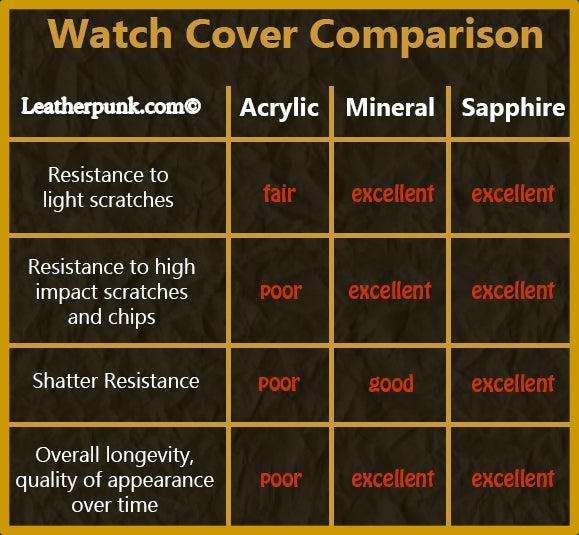
It won’t cost much more (under $100) to step into a mineral glass timepiece, and it’s a powerful indicator that this watch maker takes a serious approach at their trade, and probably incorporates other quality materials and craftsmanship into the finished timepiece as well.
My goal is to make sure you understand a little better how leather and timepieces come together in the aftermarket industry, and I hope this helps you in your buying decision.
By no means am I bashing leather craftsman who make watch accessories, either. The majority of us do a great job and provide amazing customer service. As somebody who has worked with leather for almost 20 years, I am not a major watch expert, I’m just observant and value minded…and now you can be, too. I want you to know that I place a great deal of effort and pride in my leather products and hope you give Leatherpunk a chance the next time you need a watch cuff.
